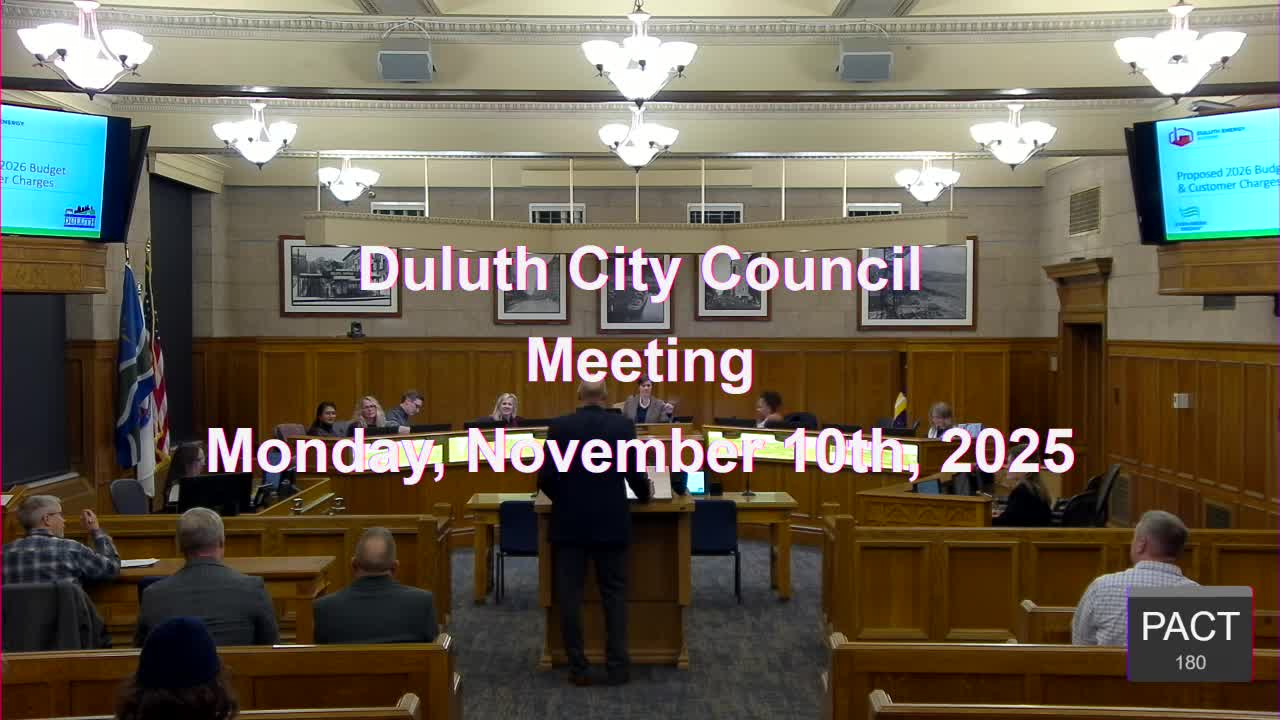Evergreen Energy outlines smaller 2026 Duluth budget, aims to cut coal use further
November 10, 2025 | Duluth, St. Louis County, Minnesota
This article was created by AI summarizing key points discussed. AI makes mistakes, so for full details and context, please refer to the video of the full meeting. Please report any errors so we can fix them. Report an error »

Evergreen Energy operations lead Mike Burns told the Duluth City Council that the company’s 2026 Duluth appropriation will be slightly smaller than 2025, at "just a shade below $15,000,000," reflecting lower expected fuel costs and a modest reduction in staffing through attrition. Burns said overall customer rates would rise about 1.1% next year, with a targeted 5.3% increase for Canal Park hot‑water customers as the utility aligns historic Canal Park discounts with downtown rates.
Burns said the system’s revenue structure separates fuel-driven consumption charges from a capacity charge that covers labor, maintenance and debt service, and that 2025 revenues trended below budget because fuel prices were lower than anticipated. He described a pass-through grant funding enhanced customer metering that will connect roughly 100 meters to a communications network so usage can be monitored in near real time, improving troubleshooting and system responsiveness.
On fuel and emissions, Burns said Evergreen has driven coal use "to almost nothing" and now uses coal only for peaking, redundancy or required annual testing. He said the transition away from coal has reduced carbon emissions by about 40% since 2012. Burns described an earlier RFP to convert boilers to remove coal capability; bids returned were too costly when debt service impacts were considered, so Evergreen is reworking the plan toward smaller, lower-rate impacts for customers.
Burns highlighted ongoing conversions from steam to hot water — now roughly 46% of loads have switched — which he said reduces energy consumption and the city’s water withdrawals from Lake Superior by as much as 20,000,000 gallons for the loads converted so far. He said plant capacity is sufficient to support additional commercial conversions and that the company plans to eliminate roughly 900 feet of steam piping as customers join the hot‑water system.
Councilor Durr Walker pressed Burns on Canal Park’s rate increase: Burns answered that Canal Park historically benefited from captured waste steam that lowered delivery costs; with that stream capture gone the system must produce or deliver heat differently, changing the rate dynamics. Burns said staff intends to continue gradual alignment of rates to avoid abrupt budget impacts for customers.
The presentation and Q&A concluded with Burns reaffirming Evergreen’s goals for 2026: adding hot‑water customers, expanding meter communications, investing in one or more boiler efficiency upgrades if feasible, and pushing coal further down in the dispatch order.
The presentation focused on budget posture, capital tradeoffs and fuel‑mix risk; Burns emphasized that any large capital project will be re-scoped if it would materially raise customer rates.
Burns said the system’s revenue structure separates fuel-driven consumption charges from a capacity charge that covers labor, maintenance and debt service, and that 2025 revenues trended below budget because fuel prices were lower than anticipated. He described a pass-through grant funding enhanced customer metering that will connect roughly 100 meters to a communications network so usage can be monitored in near real time, improving troubleshooting and system responsiveness.
On fuel and emissions, Burns said Evergreen has driven coal use "to almost nothing" and now uses coal only for peaking, redundancy or required annual testing. He said the transition away from coal has reduced carbon emissions by about 40% since 2012. Burns described an earlier RFP to convert boilers to remove coal capability; bids returned were too costly when debt service impacts were considered, so Evergreen is reworking the plan toward smaller, lower-rate impacts for customers.
Burns highlighted ongoing conversions from steam to hot water — now roughly 46% of loads have switched — which he said reduces energy consumption and the city’s water withdrawals from Lake Superior by as much as 20,000,000 gallons for the loads converted so far. He said plant capacity is sufficient to support additional commercial conversions and that the company plans to eliminate roughly 900 feet of steam piping as customers join the hot‑water system.
Councilor Durr Walker pressed Burns on Canal Park’s rate increase: Burns answered that Canal Park historically benefited from captured waste steam that lowered delivery costs; with that stream capture gone the system must produce or deliver heat differently, changing the rate dynamics. Burns said staff intends to continue gradual alignment of rates to avoid abrupt budget impacts for customers.
The presentation and Q&A concluded with Burns reaffirming Evergreen’s goals for 2026: adding hot‑water customers, expanding meter communications, investing in one or more boiler efficiency upgrades if feasible, and pushing coal further down in the dispatch order.
The presentation focused on budget posture, capital tradeoffs and fuel‑mix risk; Burns emphasized that any large capital project will be re-scoped if it would materially raise customer rates.
View full meeting
This article is based on a recent meeting—watch the full video and explore the complete transcript for deeper insights into the discussion.
View full meeting
